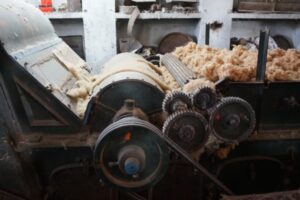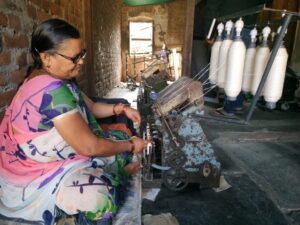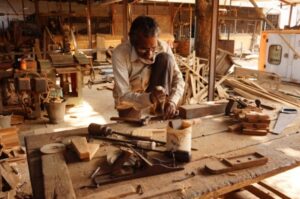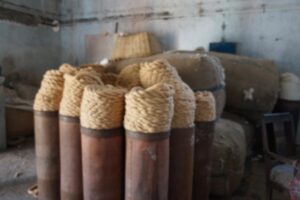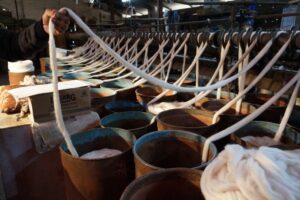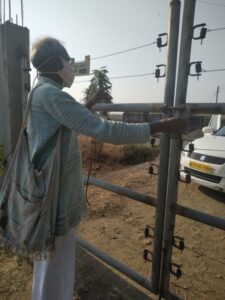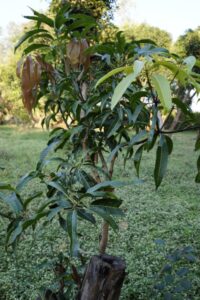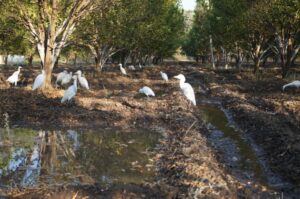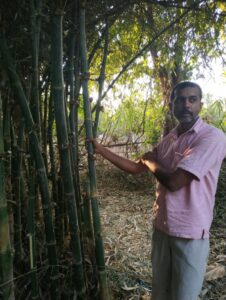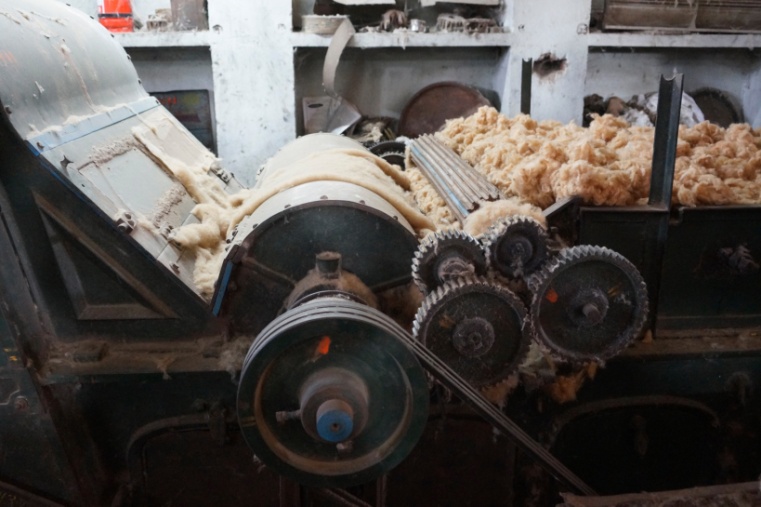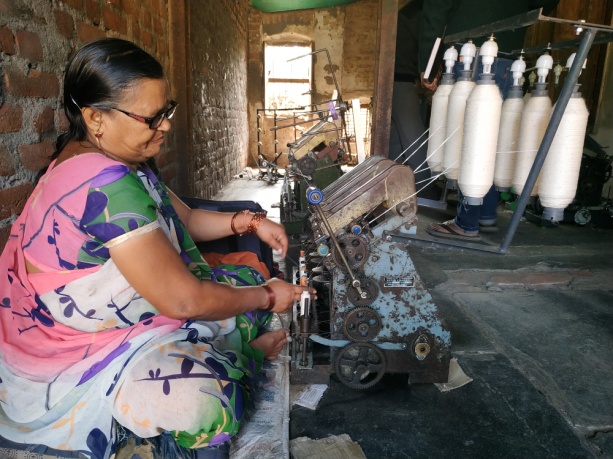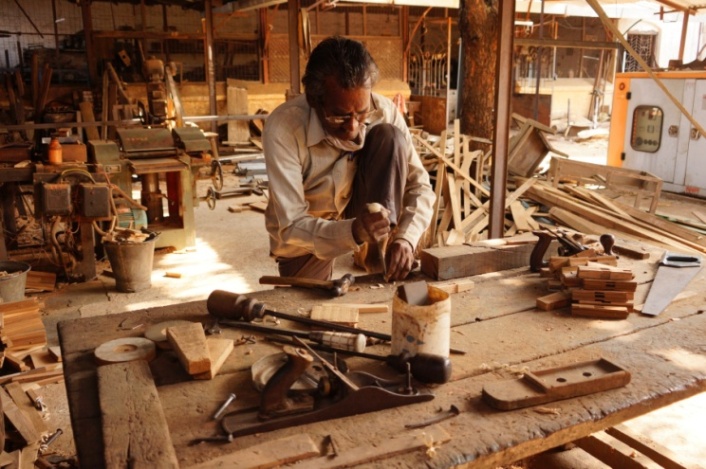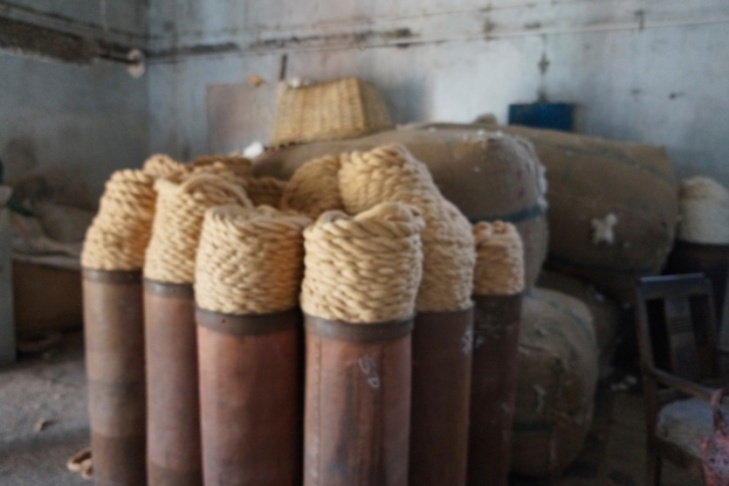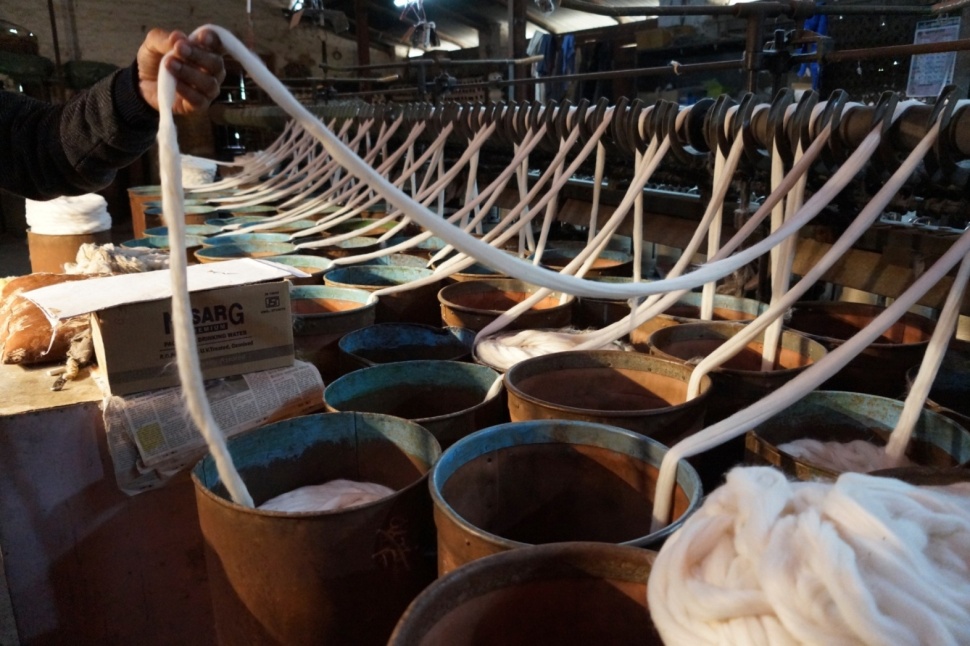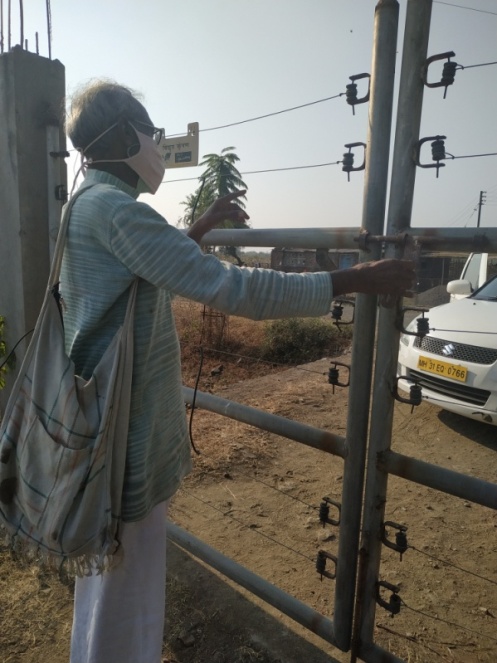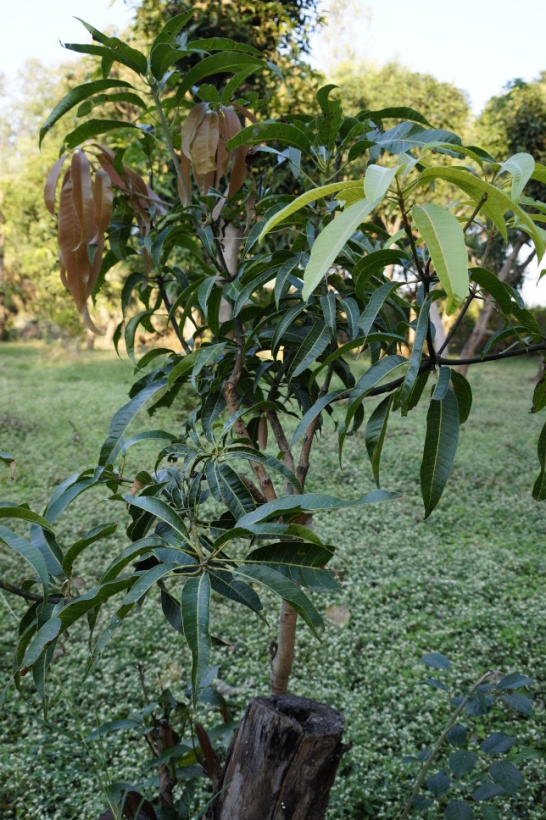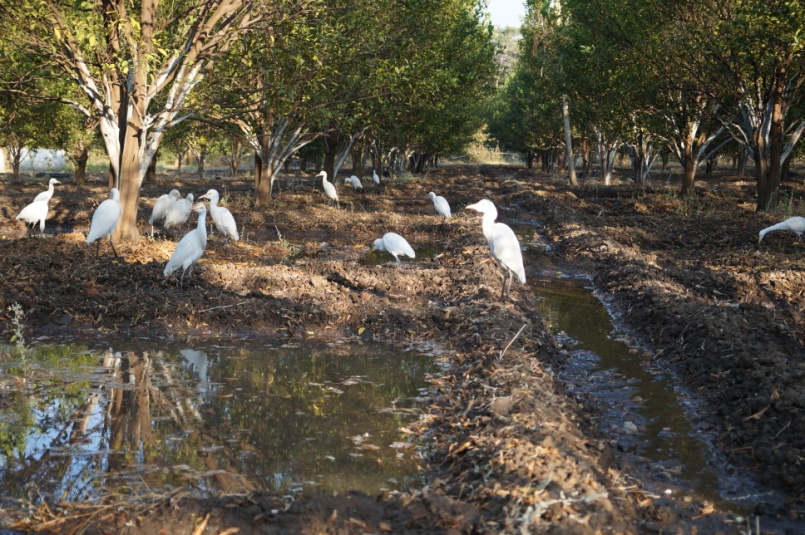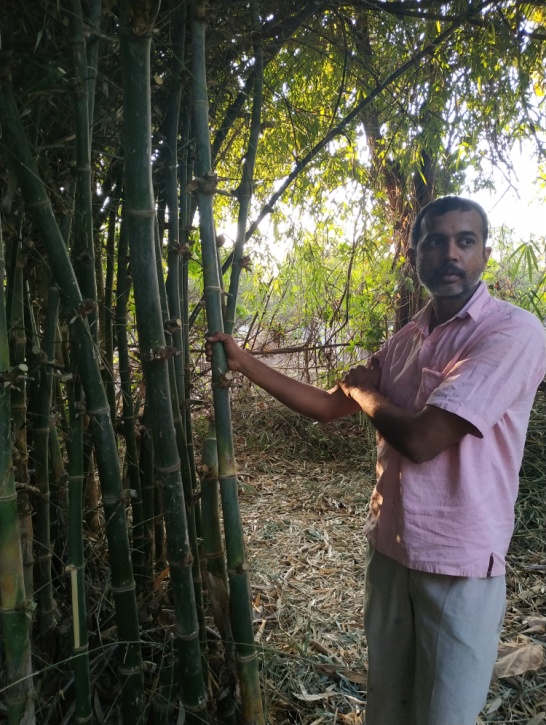If you visit Karuna tai during winters you are sure to find a grandfather basking in the sun, with fading memories but truly sharp questions. The cat here will curl up in your lap, the dogs bark in low voices, almost apologetic about disturbing the tranquility. A tall man taking large strides passes by you, with a vessel to buy milk or maybe some tea leaves. He doesn’t notice you of course. That’s Vasant dada lost in his thoughts. Inside the archaic house, Tai is quietly organizing – food, accounts and meetings. She is also the chairperson of the Gram Sewa Mandal, founded by Vinoba Bhawe in 1934 and is preparing for a meeting in Nagpur. The cat and people in the house are a bit unsettled with the possibility of Karunatai’s absence for a couple of days. Tai smiles gently, “We have to keep moving. Routine does not suit us. Challenges keep us going…”
We had arrived the night before. Vasant da dismisses the idea of staying elsewhere. “Such a waste of money and fossil fuel!” That’s the beginning of our association with this couple, with seamless conversations spread across cooking, eating, cleaning together and walking through the Jajoo farms. Together, they make for a potent scientist-researcher-practitioner team who have spent more than four decades experimenting, exploring organic farming as a science. A lifetime of work is now a flourishing farm, a laboratory for others to learn in, including their own children.
Mornings, you can hear the ginning mills hum gently in the campus. We learn about the “Cotton to Cloth” process in the workshop. Huge machines aided by workers turn out bales of cotton that will go into spinning yarn, which will be further used in the handlooms. The meticulously coordinated process engages women from the nearby communities. The finished products are available in the shop. The campus also houses a cold press oil mill where we witness the crushing of coconut, peanuts and sesame to extract oil. It is close knit combination of machines and human beings; run with precision. Senior artisans create parts for the box charkha – a modified version of the original charkha. The unit has a dedicated customer base in cities, both in India and in foreign countries as well. A machine charkha sits in Karuna tai’s sit out as well. An inmate of Vinoba Bhawe’s ashram, growing under his care, Karunatai remembers, “He was more of a saint than an activist. The institution engaged women from the nearby villages in spinning work. Today they earn a basic income which allows them to buy vegetables and other essentials that they couldn’t afford earlier. Many women continue spinning even with grown up children in well-paying jobs. For us and them, Spinning is a way of life. We had engaged 103 women, but the numbers drastically came down during COVID 19 period when our unit was hit by losses.”
In 1929, when Vinoba Bhawe arrived here, he learnt that women were paid meagre wages. Any talk about wage increase saw resistance. For the next 6 months, Vinoba carried out spinning for 8 hours and ate only what his wages allowed him to. He was reduced to a bag of bones! He thus established that the wages were not enough for people to subsist. The tone was set for development in the spinning industry. Later, research and development was initiated around the charkha and new models were built to improve the speed and overall quality of work. Post Freedom, Wardha became the centre of Khadi. Around 1953, some people came together to establish a community living model, growing food and working together to demonstrate a sustainable life, with minimal use of money.
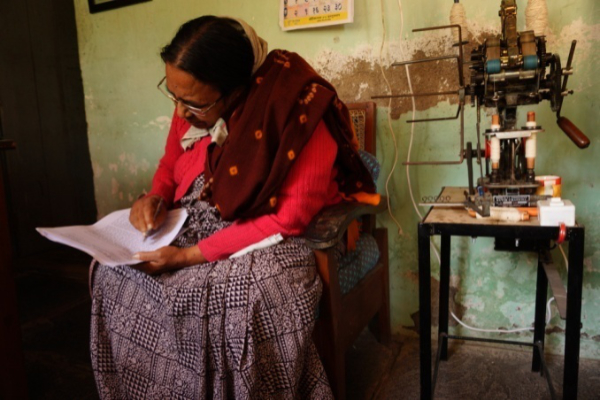
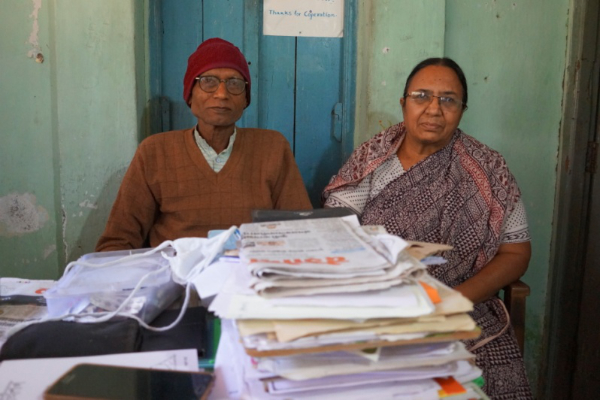
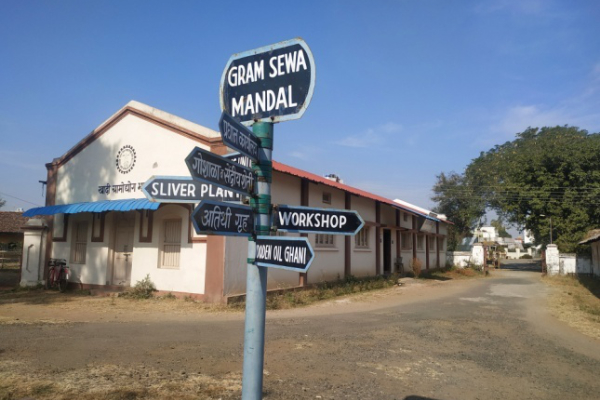
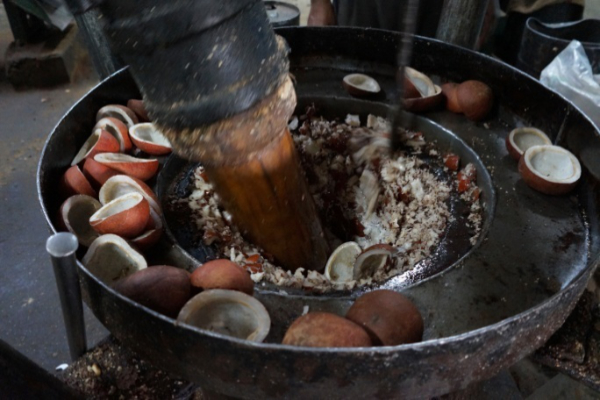
Dr. Jajoo Farms: Demonstrating Soil Conservation Practices
A solar powered and guarded electric gate greets us at the entrance of Dr. Jajoo’s lush green farm of about 5 acres. Dr. Jajoo is a close friend of the Futane family and has allotted this land for the practice of organic farming. This is where Vasant da has spent his last 4 years experimenting with organic farming techniques. He shows us his meticulous photo-documentation of the Rawala farms which has been his site of learning. Contouring, Bunding, selecting trees to act as wind-shields, irrigation process, soil conversation, exploring new varieties of plants, the practice of mulching, using organic manure are some of the proven techniques.
Vasant da says, “The topmost soil up to 6 inches is called “malai” (cream). This 4-6 inch zone is the most important. Even for a large tree like the neem, the topsoil of 5-6 inches is very important for its growth. But this top soil gets washed away with each rains. The more you plough the land, the more is the loss of top soil. Contouring can help arrest soil erosion to some extent. For this is very important to understand the topography of the land. If the field is at a 3% slope (3 metres of slope in a 100 metre patch of land), then you can take a contour at half meter vertical distance. A farmer can learn this method in a couple of days.”
The Jajoo farm is in its 4th year of progress where Vasant da has introduced this method. “Some farmers are alert about not letting the soil flow out of their farms. But the top soil does flow down downwards and collects at the bottom of the farm. That’s why you can see better plant health at the bottom. It’s like Ethopia and California in the same land! Bunding also helps retain soil moisture, leading to improved production. Rainwater will also seep better into the land. This is called In Situ Rainwater Harvesting. The running water is checked to flow slowly; the flowing water has to be harvested. This is very useful technique to be implemented in the Bundelkhand region of MP expect where rice is grown. If we adopt this method, our crop production will increase right from the first year.”
We learn that soil moisture in the right quantity and at the right time, rather than water itself is the core requirement for better production. Vasant da and his friends have trained many farmers in Vidharbh region, to adopt this method through two days of training. When Paani Foundation adopted this method, entire villages witnessed improved quality of drinking water and improved crop production. Farmers who earlier talked about kilograms of produce started talking in terms of quintals.
We ask if levelling of land is an option to contouring. Vasantda says, “Levelling disturbs the topography! Levelling is expensive; also it uses a lot of fossil fuel. It only displaces the topmost most fertile part of the land. You lose considerable surface area as well. It’s best to maintain the natural contours.”
But will bullocks, the key resource in traditional farming, be able to navigate through the contours while ploughing? Vasant da smiles at our question, “Animals are very intelligent. They understand the land much better than we do. Once you draw a line and lead them through it, they will follow similar lines later. It will also lead to a better irrigation system, when the water will not rush but flow gently and evenly through the contours. A friend of ours Subhash Sharma planted Tomatoes on the top and spinach at the bottom. Tomatoes were harvested first and spinach later. Mixed cropping saves water. The farmer is assured of at least one crop.”
“Sometimes we experience heavy rainfall. That’s when we require effective drainage systems. We have created a system where all the excessive rainwater flows through the drainage channels and reaches the pit near the well, thereby recharging the well. Maximum work on our fields is towards water harvesting.” About the increasing global warming, Vasant da says, “its upto the farmers now to plant more trees and contribute their bit to reduce global warming. Trees like the Neem are a “Kalpavriksh” for the farmer. Despite the shade, crops will grow very well under a Neem tree.”
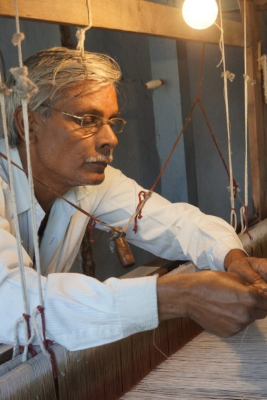
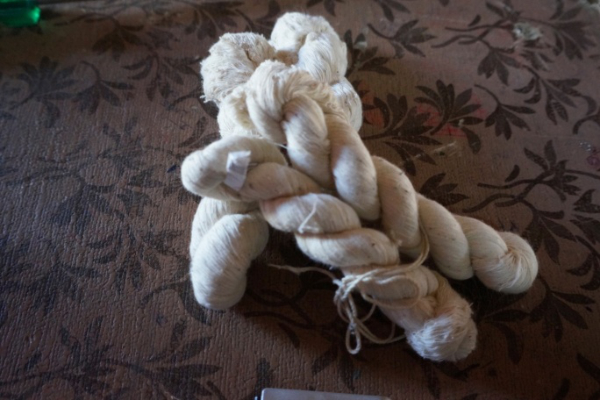
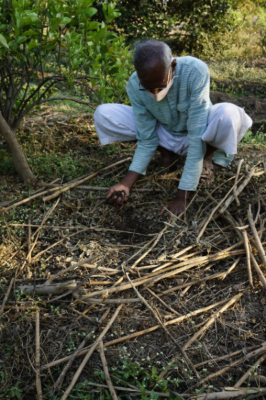
Pointing the trees on the boundaries, Vasant da says, “These trees are wind breaks for the heavy winds from the North and West directions. Heavy winds damage crops, especially fruit trees and cause evaporation increasing water use. So, we plant trees in a three tier system at different levels.Leaves are used for mulching. Mulching covers the earth, to retain soil moisture, warmth and increase compost activity especially by earthworms. Ideally, organic matter has to be retained at minimum 1%. At our farm, it might be 2% after four years of work. Farmers should also not burn or throw away farming waste. Ideally most the bio mass should go back to the soil. Today, despite mass production, we are getting more of biomass and less of grains. Morever the farmer is not getting MSP for key crops like oil seeds. How will the farmer survive? Policies are faulty…
Fukuoka’s “One Straw Revolution” comes up in our conversation. Vasant da exclaims, “It’s a bible for farmers! It is a vision building document. It is possible to combine soil conversation with rainwater harvesting and wind management. There is no point in raising slogans about saving the environment. It’s time to act. My prime responsibility is to save the earth, conserve water.”
Vasant da emphasizes that marginal farmers who own less than 2-3 acres of land can easily take up organic farming practices if they have good land, irrigation systems. But in difficult terrains like Maharashtra where rainfall is scarce, it may require upto 10 acres of land to establish good organic farming practices. He says, “cash crops have led to land deterioration and increased pest infestation. If the crop cycle with annual and perennial crops is maintained at longer durations, the land fertility can be sustained. Inter cropping practices may help. Plants like turmeric, yam, ginger can grow well in the shade of bigger trees.”
The Jajoo farm is a personal land holding and therefore creates interest among those who wish to understand the feasibility of organic farming practice by individual farmers. Vasant da asks, “Do you see any deficiency in the plants here? They are healthy! We don’t need any chemicals at all…everything is managed with cow dung and cow urine. Every farmer should construct a good cowshed so that the cow urine can be collected in one place. Cow urine is more precious than cow dung. The government can take a decision to support farmers in building cowsheds and in return buy cow urine from them. They are already spending so much on urea procurement. There is no need for urea at all!”
We see a patch of Tur dal plants laden with beans. “That is because we have strengthened the soil. You can see the plants bending with all the beans! I got the seeds from farmers in Rajasthan.” We can see some cherry tomatoes as well. “These are a bigger version of cherry tomatoes”, says Vasant da. “They will never be infested with pests. This is the magic of Amrut Jal – a combination of cowdung and cow urine.”
There is some Tapioca from Kerala as well, “It is growing well here, despite being from a different state.” Egg plants, of a huge size, of the Karnataka variety are also growing in this cluster. Vasant da says, “if 20-25 farmers together grow a particular variety of millets, the birds and humans as well get their share of the crop! Else, it’s difficult for a single farmer to keep the birds away from his millet crops.”
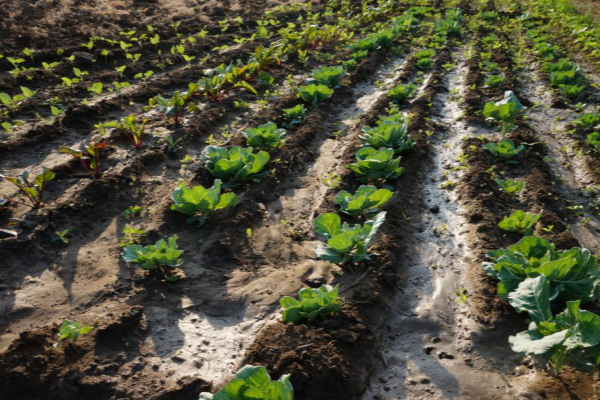
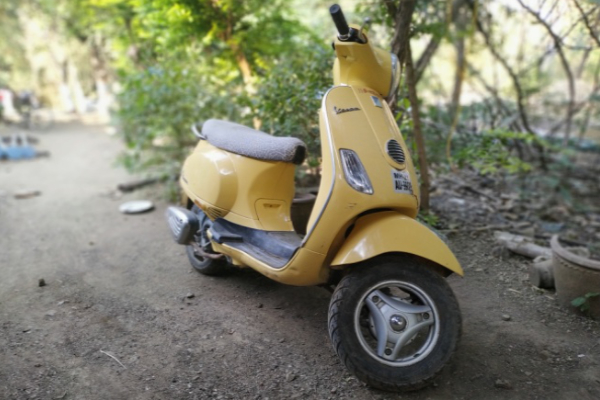
Vasant da digs out a handful of earth, “see, the biomass waste of 4 months is slowly becoming porous soil, brought upwards by the earthworms. If you have to learn about soil, you need to come to the fields, not in classrooms! Here, a family of 4-5 adults can work, earn and subsist on this farm alone.”
A patch of onions, oranges and Mosambi plants are also growing well. Fenugreek patch has been kept for its seeds. Mustard is growing on its own. Potatoes, cabbage, beetroot, cauliflower, beans, Moringa, three different varieties of bananas and shevari grass are growing as well. Vasant da shares, “If planted in June, a beans patch will give the first batch of harvest in September and continue giving till March. Unlike cauliflower which has to be planted all over again. Tubers give back a lot to the soil like Radish and Yam. They are a complete food on their own.”
Vasant da has selected plants that can grow in weak soil like sitaphal, moringa, chriaunji. They have Mahua and red sandalwood as well. It has traditionally been used by tribal communities as a medicine. Vasant da exclaims, “But we realized its value only when the Japanese started buying this from us.”
“There will be atleast 200 varieties of seeds in my Rawala farm. Here, we may have about 50 varieties of trees and around 100 varieties of other crops. Bananas have to be saved from warm winds. Hence trees are planted in the West and North ends. There are different varieties of mangoes as well, including the grated varieties. The field is seamless with medicinal plants, trees, food grains, creepers, tubers all growing together with systematic planning. Chickoo, Pomegranate trees can also be seen.
Vasant da is showing us the wheat fields. He says, “A model farm needs trees. We need to explain this to the farmers. The science is that till 11 am to 12 noon the plants should get enough sunlight for photosynthesis. That’s why we have planted small plants in the East and South directions. Large trees like the Neem we have to plant towards the North and West directions. We can plant tubers under the shade of these large trees and earn money out of it as well. There is a huge demand for forest foods in big cities.”
After a walk of over 90 minutes we are ready to take a break. Vasant da however is full of energy, “Come let us pull out some saag for dinner! The enthusiasm is infectious, but the Rawala farms call us and we set out to meet Chiu or Chinmay and his elder brother Vinay. It is tough to bid goodbye to the couple, but we promise to come back for more training, exposure and documentation related work.
Baba says, “Don’t focus too much on money. Concentrate on your writing. Write well or your younger colleagues will also fall behind in writing.” We carry this precious advice with us to our onward journey.
Rawala Farms: A Journey of Acceptance of Organic Farming Practices
Rawala lies in the Satpura range, at the MP and Maharashtra border, about 140 kms from Wardha and 110 kms from Nagpur. The 35-acre farm had been developed by Vasant da and Karuna tai over 40 years of dedicated work. Vasant da belongs to the Mali community who traditionally grow vegetables. Karuna tai was born to a Bihari mother and a Gujarati father Ranjeet bhai Desai who headed the Gram Sewa Mandal. She had grown up in a Brahmacharini ashram.
Vasant da and Karuna tai met each other in residential camps organized by Tarun Shanti Sena. Eventually, they decided to get married in 1981 primarily because they had similar ideas about leading their lives. Says tai, “we would write letters to each others. These were more of news bulletin than love letters! We did not know any other way of expressing our love. We talked only about work. That’s how we were…we continue to remain good friends, standing by each other through thick and thin.”
Vasant da says, “In 1987, we learnt about Fukokwa’s “One Straw Revolution”. One of our senior friends immediately made photocopies of the same and organized reading circles. This exposure enriched our knowledge of natural farming. We formed a collective of 5-10 people who would work on developing a model farm, for further expansion. We had 50 acres of land in our joint family, but they were unwilling to give it away. It was only after a protracted struggle, full of hardships that we were finally got access to some stony land where it was impossible to grow anything! It is here in this land that we demonstrated the possibilities of organic farming.”
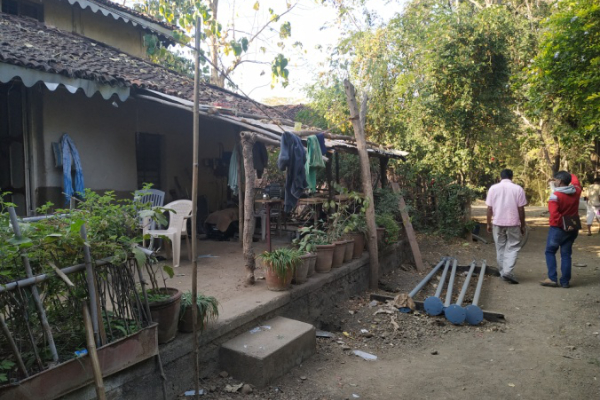
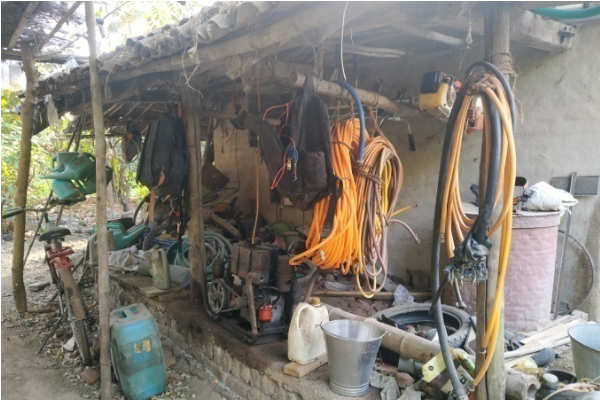
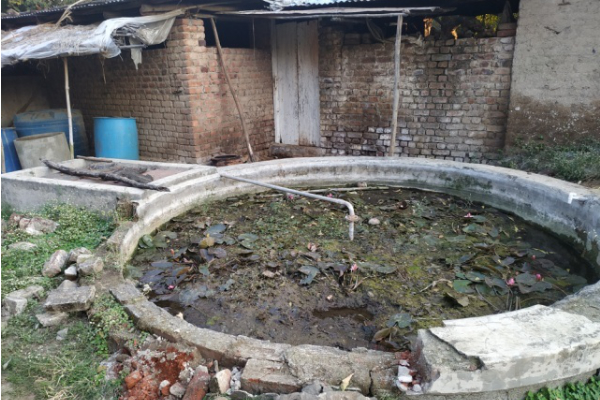
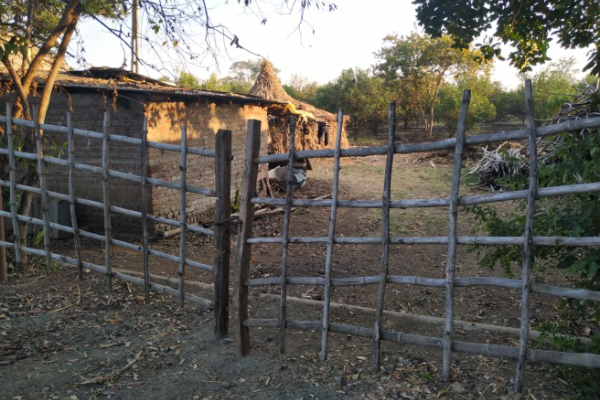
Reflecting on their journey, Karunatai says, “When we create a new path, life becomes a struggle. People found our ideas and farming practices weird. We were dismissed as a crazy family who worked on infertile, rocky land. Gradually, nature guided us through and we could demonstrate sustainable organic farming processes, even establishing a steady market for our organic produce. The day came when our sons were able to sell a 10/- rupees per kg produce fro 40/-. My view is that the Rawala farm work can be done only by Agricultural scientists.”
Vasant da’s narrative emerges from his observations of the current crisis in agriculture and allied practices. “Post the Green Revolution, the soil is polluted. The crops are poisoned. Soil fertility has gone down. We are witness to newer variety of pests and plant infections. Chemicals with high levels of toxins are being used at a massive scale. This mindless destruction borne out of human greed requires repair and intensive engagement with farmers themselves. Some farmers are experimenting on a small scale, but it is not enough. We are fighting a bigger catastrophe…”
A thought that is reflected by his younger son, Chinmay.
Chinmay & Vinay: Exploring Organic Farming as a Viable Economic Model
There’s an air of ease around Chinmay. The tone of conversation remains even and not once do you see the urgency of getting a point across. We are sitting in the Futane family’s mud-house at Rawala, built by Vasant da and Karuna tai, about 30 years ago, surrounded by a diverse range of plantations including bamboo, mango, oranges, lentils, wheat among others. The front yard has a workshop shed where they build their own need-based farming implements. The bio-gas plant, vermin-compost pit, cow urine collection pits have been built to aid the farm functions. Fodder for animals is grown separately and the irrigation system too has been developed across years.
Chinmay and his older brother, Vinay are tech-savvy organic farmers who have successfully demonstrated the feasibility of organic farming, including a growing market for his produce. Chinmay says, “We have always lived here. I dropped out of school in class 10. Later, I went out to work with Paani Foundation for 2 years. Apart from this I have spent my entire life here. It has been a conscious decision to stay here and continue work on the farm. A bit differently from our parents though, who have little interest in the economics of organic farming. But we were keen to establish a market for our organic produce. We did and have managed to sustain the same even through the COVID period.”
“We are much admired today. Our varieties of mangoes and oranges are pre-booked even before harvest. We adopted the open market system of selling. Through direct selling we are able to market to different cities as well. But more importantly, we have our customer base among the locals, despite the slightly higher prices. Today we can sell produce that earlier went for 10/- at 40/-now. But it was not so earlier. We, our family were ridiculed, called crazy because they worked in thorny feilds with no chemicals and with little yield. Today, organic farming and organic produce has become a matter of prestige. That’s how things have changed in the last 30-35 years. People have understood the relevance of organic farming. There is acceptance.”
Chinmay shares how the rampant use of pesticides is destroying farms. “The threat is visible now. Cases of people dying after spraying in feild are coming out. Today, the farmer is using a stronger pesticide, while the body immunity has declined. Yavatmal especially has started recording such cases. The farmer, farm labourers, customers all know that this is harmful. Yet, this continues…”
“Initially we did not grow Oranges since they were a cash crop and could lead us to mono-culture of cropping. There is huge consumption of water as well. We introduced Bamboo as an alternative. It did well. About 8-10 years ago, we planted oranges. They are of a good quality, our perspective changed… There is no comparison for the quality of our orange crop today. We also are focusing on specific produce like Tur Dal, Turmeric, Wheat, Rice, Mustard, Sesame, Mangoes and Bamboo, especially those used in construction, arts & crafts, in basket and ladder making. There is no middle man involved in our bamboo sale.” Direct selling has created a dedicated customer base which is handled online and through an effective distribution network. The most basic pack contains 10 kgs of Mangoes and 20 kgs of oranges. The rates have improved as well from 150/- per kg to 180/- per kg. The brothers are now planning to set up a FPO to ensure a direct reach to seller and engage more farmers. We bring up the question of certification, “Who are they to certify us, our produce?! We have been around for more years! We certify ourselves, you are most welcome to visit us, understand our work and taste the produce.”
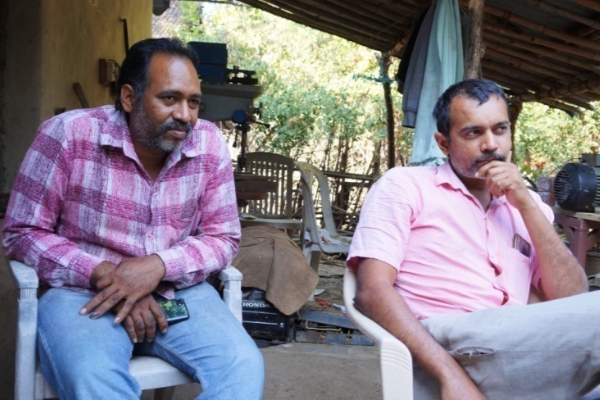
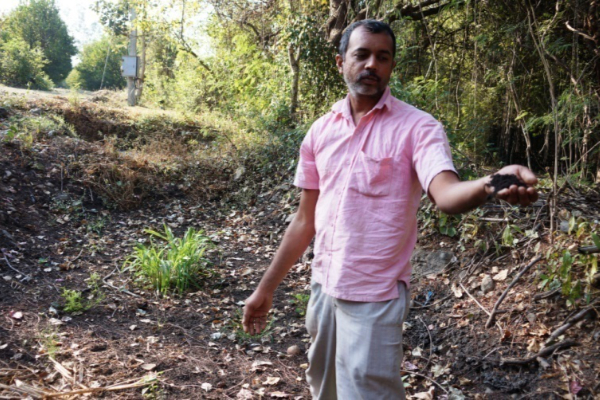
The confidence stems from his almost three decades of work on the farm, having witnessed his parents work on the land, researching and exploring newer ways of farming.“As a young person, I had nursed a complex about my parents’ work. I did not understand him fully… But later, many visitors would come here to see his work. It gradually dawned upon me that I want to pursue this work. I started building my vision towards this. Today, this sense of pride comes with my organic mango produce. There is no comparison for our mangoes in the market!”
The mud house where they continue to live had been initiated by his parents in 1999. They came to live here in 2003.Rawala lies in the interiors, yet the brothers have maintained their connect with the world outside, without allowing to be swayed by it. Chinmay says, “we see a lot of videos on you tube. It is easy to get distracted. We are doing this because it is the right thing to do! That’s our thought, what my father believes in. But what about others? Are they interested?”
“The basic principle of Organic Farming is that it will not work if you invest money and do it just for money. Farming cannot be a part-time, remotely monitored activity. It’s a completely hands on process! Even if you have a small farm, you need to be in there each day, to nurture it….European countries follow strict norms in grading while exporting produce. Organic farming needs more investment beyond money. We have to make it a trend where everyone would want to practice it. The core thought is not to make money and sell the produce at better rates. If you wish to practice Organic Farming, you will have to learn to bow before nature. Nature teaches you. We need to lessen our false pride and stop behaving like God! The point in selling is “Optimum” not “Maximum”.
But how does this individual body of work reflect in the community? Is this stand alone or is there a connect? Chinmay shares, “People especially the younger farmers come to us for learning, we hand over small tasks to them. Someone wants to know about digging wells, building a bamboo toilet, homestead farming, about drip irrigation, storing harvest among others. Sometimes we guide them through health, finances and provide support in emergencies. A small farmer needs to invest about 2 ½ to 3 lakhs initially for Organic Farming. The basic requirement is of fencing, a well, storage facilities, seeds and care of crops during summers. Protracted irrigation is required. A farmer may spend upto 10 hours a day for watering the fields. Load shedding makes the task difficult. Investing in Solar energy is good, but it does not function well in cloudy weathers. Not many are able to invest in these resources. We try to help in our own ways…”
We walk around some part of the Rawala farm especially inside the Bamboo forest, the Mango, Orange and wheat fields. It’s a self sustained ecosystem. Little Panati , the youngest in the Futane family, Vinay’s daughter says, “Kaka (uncle) has no rest! He is up at 4 am to shoo off the birds!”
As we travel back home, we mull over the choices that people make in their lives. As tai says, “Well you have right to make the choices, but the real test is to stand by your choices and work through the difficult phases, not give up on your conviction. If your work has impacted people, communities and demonstrated a different way of life, you are somewhere on the right path. Keep going…”
More Photographs
